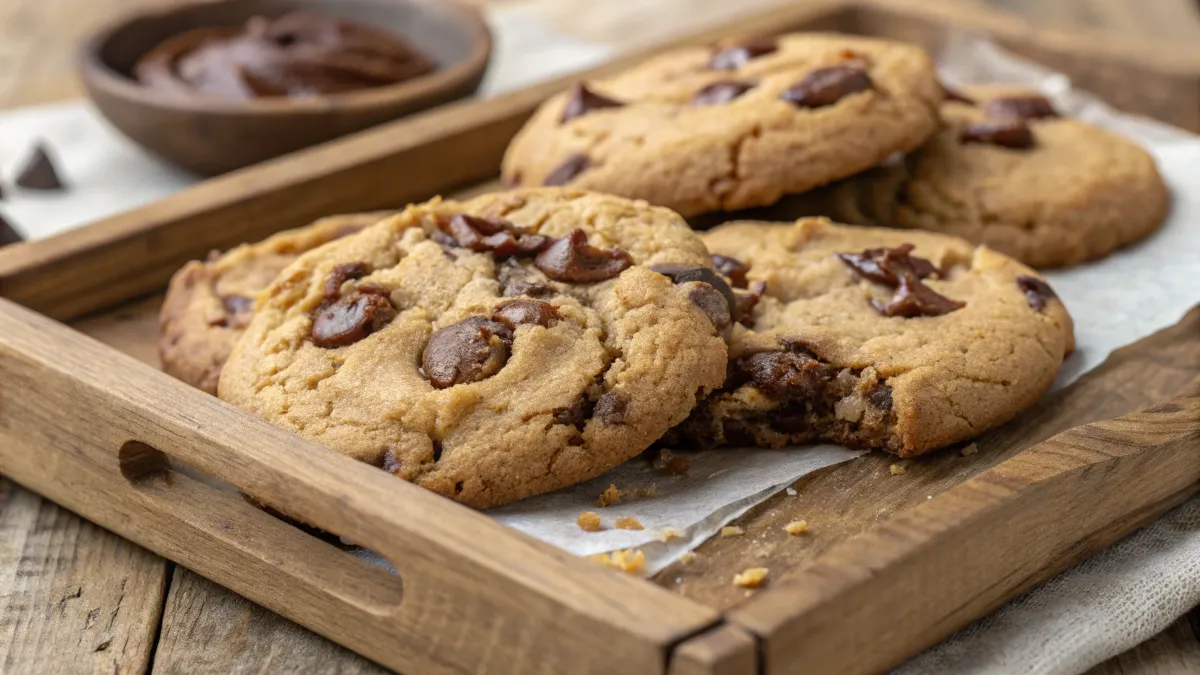Introduction
There’s nothing quite like biting into a warm, chewy cookie. That perfect balance of softness and stretch keeps you coming back for more. But what’s the secret to achieving that irresistible texture? Why do some cookies turn out crispy while others remain soft and chewy?
The key lies in ingredients, techniques, and baking methods. From sugar ratios to baking temperatures, every little detail affects the final texture of your cookies. In this guide, we’ll break down the science of cookie chewiness and give you all the tips you need to create the perfect batch.
Whether you’re a home baker or a cookie enthusiast, this article will help you master the art of chewy cookies. Let’s dive in!
Table of Contents
What is the Secret to Chewy Cookies? – The Science Behind Texture
The Science Behind Cookie Texture
The texture of a cookie is determined by a combination of moisture, fat content, sugar type, and baking method. Here’s how different factors influence chewiness:
| Factor | Effect on Cookie Texture |
|---|---|
| High Moisture Content | Makes cookies soft and chewy by preventing excessive drying |
| Brown Sugar | Adds moisture and chewiness due to its molasses content |
| Egg Yolks | Contribute to richness and softness |
| High Baking Temperature | Helps cookies set quickly while keeping the center moist |
| Underbaking | Prevents cookies from becoming too dry or crispy |
By understanding how these elements interact, you can tweak recipes to get the texture you want.
Differences Between Chewy, Crispy, and Soft Cookies
Cookies generally fall into three main texture categories:
| Texture | Characteristics | How to Achieve It |
|---|---|---|
| Chewy | Soft, slightly dense, with a slight “pull” | More brown sugar, melted butter, egg yolks, and high moisture |
| Crispy | Thin, firm, and crunchy with a snap | More white sugar, less moisture, longer baking time |
| Soft | Light, fluffy, and cake-like | More butter, baking powder, and lower baking temperature |
Why Some Cookies Turn Out Dry or Hard
If your cookies are turning out too dry or hard, you may be making one of these mistakes:
- Using too much flour – This can absorb too much moisture, making cookies dry.
- Overbaking – Baking cookies too long removes moisture and makes them crispier.
- Not enough sugar or fat – Sugar and fat help retain moisture and softness.
- Lack of egg yolks – Yolks add richness and chewiness to cookies.
Making small adjustments to your recipe can dramatically improve the texture of your cookies.
Key Ingredients for Chewy Cookies
The Role of Fats: Butter vs. Shortening
The type of fat you use in cookies affects their texture:
| Fat Type | Effect on Cookies |
|---|---|
| Butter | Adds rich flavor and spreads more, making cookies thinner and softer |
| Shortening | Creates thicker, softer cookies with less spread |
| Oil | Makes cookies extra moist but can lead to a greasy texture |
For the chewiest cookies, a mix of melted butter and a little shortening works best. The melted butter ensures chewiness, while shortening helps retain moisture.
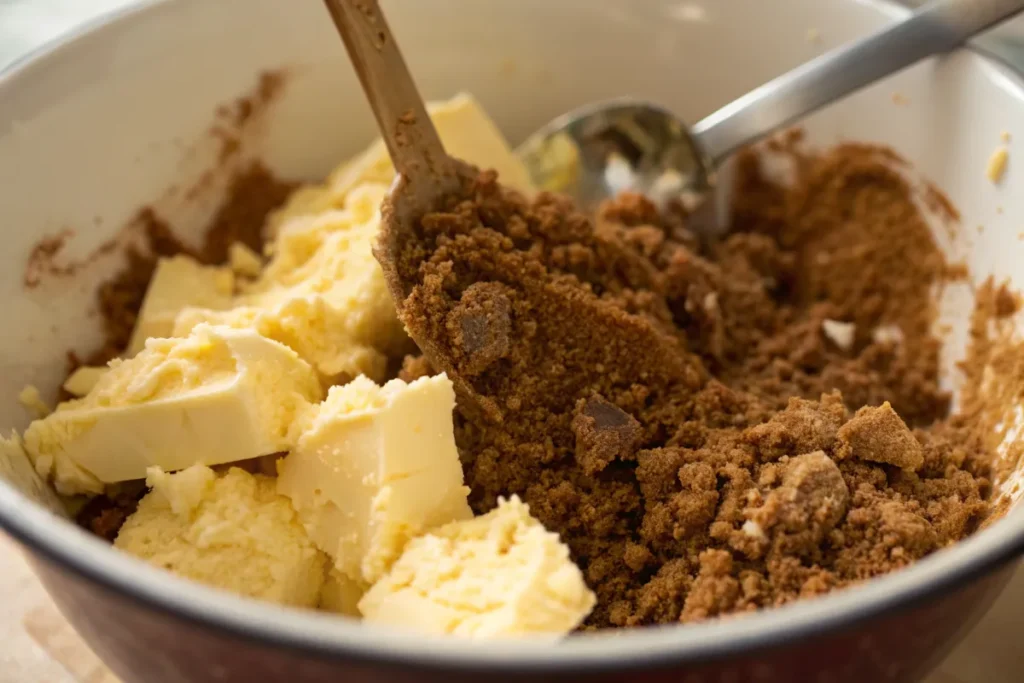
Sugar Ratios: Brown Sugar vs. White Sugar
Sugar plays a critical role in cookie texture. Brown sugar contains molasses, which adds moisture and chewiness.
| Sugar Type | Effect on Cookies |
|---|---|
| Brown Sugar | Creates soft, chewy cookies due to moisture retention |
| White Sugar | Leads to crispier cookies with more spread |
| Honey or Molasses | Adds extra moisture for ultra-chewy cookies |
For maximum chewiness, use at least 50% brown sugar in your recipe.
Eggs and Yolks: Impact on Chewiness
Eggs provide structure and moisture in cookies. Using more egg yolks instead of whole eggs results in richer, chewier cookies.
| Egg Variation | Effect on Cookies |
|---|---|
| Whole Eggs | Balance structure and moisture |
| Extra Yolks | Add richness and make cookies softer and chewier |
| No Eggs | Results in dry, crumbly cookies |
A good rule of thumb: If a recipe calls for one egg, try adding an extra yolk for more chewiness.
Choosing the Right Flour for Texture
Flour provides structure to cookies, but different types affect texture differently:
| Flour Type | Effect on Cookies |
|---|---|
| All-Purpose Flour | Best for a balance of chewiness and structure |
| Bread Flour | Adds extra chewiness due to higher protein content |
| Cake Flour | Produces softer, more delicate cookies |
For ultra-chewy cookies, use bread flour or a mix of bread flour and all-purpose flour. The extra protein helps create a chewier bite.
Moisture Content and Hydration
How Moisture Affects Cookie Chewiness
Moisture is the key to chewy cookies. A lack of moisture makes cookies dry and crumbly, while higher moisture results in a softer bite.
Why Chilling Dough Improves Texture
Chilling cookie dough helps control spread and intensifies flavors. It also allows flour to absorb moisture, resulting in a better texture.
| Chilling Time | Effect on Cookies |
|---|---|
| No Chilling | Cookies spread more and have a lighter texture |
| 30 Minutes | Slightly thicker cookies with better flavor |
| 24 Hours | Enhances chewiness and deepens flavor |
For best results, chill your cookie dough for at least 1 hour, but overnight is ideal for maximum chewiness.
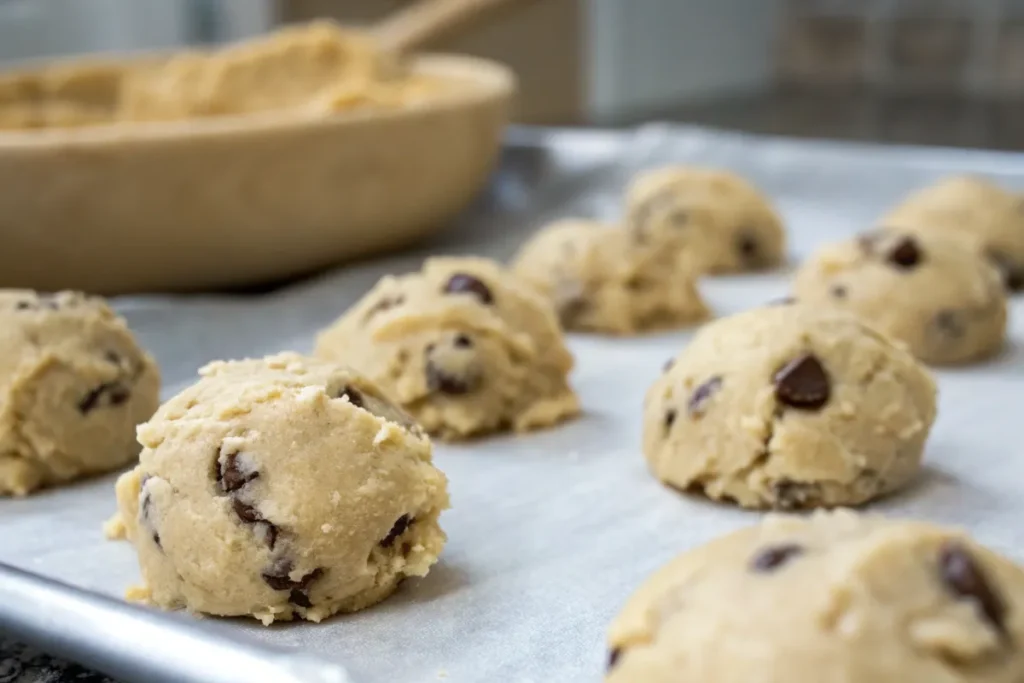
Using Liquid Ingredients to Enhance Chewiness
Adding small amounts of liquid ingredients can keep cookies moist and chewy:
| Liquid Ingredient | Effect on Cookies |
|---|---|
| Milk | Adds tenderness and softens texture |
| Corn Syrup | Boosts chewiness and prevents drying |
| Molasses or Honey | Increases moisture retention |
Just a tablespoon of corn syrup, molasses, or honey can make a big difference in cookie chewiness.
Baking Techniques for Chewy Cookies
How Baking Time Affects Texture
Baking time plays a crucial role in determining whether your cookies turn out chewy, soft, or crispy. If cookies bake too long, they dry out, resulting in a firmer texture.
| Baking Time | Effect on Cookies |
|---|---|
| 8-9 minutes | Very soft, slightly underbaked, ultra-chewy |
| 10-12 minutes | Balanced chewiness with a firm edge |
| 13+ minutes | Crispier, drier cookies with less chewiness |
For the chewiest cookies, remove them from the oven when the edges are set but the center still looks soft. They will continue baking as they cool.
Ideal Oven Temperature for Soft and Chewy Cookies
The oven temperature affects how quickly the cookies bake and set. A higher temperature leads to a crispier edge, while a lower temperature results in a softer interior.
| Oven Temperature | Effect on Cookies |
|---|---|
| 300°F (150°C) | Very soft, cake-like texture |
| 325°F (163°C) | Balanced softness and chewiness |
| 350°F (175°C) | Classic chewy texture with a slight crisp edge |
| 375°F (190°C) | Faster baking, slightly crispier edges |
For the best chewiness, bake cookies at 350°F and keep an eye on the baking time.
Why Underbaking Helps Retain Moisture
Underbaking is one of the best tricks for chewy cookies. Removing cookies from the oven a minute or two early ensures they stay moist inside.
- Underbaked cookies stay soft longer and have a fudgy texture.
- Overbaked cookies lose moisture and become crisp.
For maximum chewiness, take the cookies out when the edges are firm but the center still looks slightly raw.
Mixing Methods That Affect Chewiness
Creaming Butter vs. Melting Butter
The way you incorporate butter into cookie dough greatly affects texture.
| Butter Type | Effect on Cookies |
|---|---|
| Melted Butter | Produces chewier cookies with a denser texture |
| Softened Butter (Creamed) | Creates a lighter, airier texture with more structure |
| Cold Butter | Results in thick, firm cookies with less spread |
For chewy cookies, using melted butter is the best approach. It allows the flour to absorb more moisture, giving the cookies their characteristic chew.
Overmixing vs. Gentle Mixing
The way you mix your cookie dough can make or break its texture.
| Mixing Method | Effect on Cookies |
|---|---|
| Overmixing | Activates gluten, leading to tough, dense cookies |
| Gentle Mixing | Keeps cookies soft and tender by limiting gluten development |
For chewy cookies, mix the dough only until the ingredients are combined. Avoid excessive stirring, which can make cookies tough.
The Importance of Resting Dough Before Baking
Letting cookie dough rest before baking enhances flavor and texture.
| Resting Time | Effect on Cookies |
|---|---|
| No Resting | Cookies spread more and have a lighter texture |
| 30 Minutes | Slightly thicker cookies with deeper flavor |
| 24 Hours | Maximum chewiness and enhanced caramelized taste |
For the best chewiness, refrigerate the dough for at least 1 hour, or ideally overnight. This helps the flour absorb moisture and results in a better cookie texture.
Additives and Secret Ingredients for Chewiness
Cornstarch: A Game-Changer for Soft Cookies
Cornstarch is a secret ingredient that helps create softer, thicker, and chewier cookies.
| Cornstarch Amount | Effect on Cookies |
|---|---|
| None | Regular texture with some spread |
| 1 teaspoon | Slightly softer and thicker cookies |
| 1-2 tablespoons | Ultra-soft, thick, and chewy cookies |
Adding 1-2 tablespoons of cornstarch to your cookie dough can help retain moisture and prevent excessive spreading, making the cookies extra chewy.
Using Honey or Molasses for Moisture Retention
Honey and molasses are excellent natural humectants, meaning they attract and hold moisture.
| Ingredient | Effect on Cookies |
|---|---|
| Honey | Makes cookies softer and slightly sticky |
| Molasses | Deepens flavor and adds extra chewiness |
| Corn Syrup | Keeps cookies soft for longer |
For chewier cookies, replace 1 tablespoon of sugar with honey or molasses. This will help retain moisture without altering the overall structure too much.
If you love chewy cookies, try these Vermont Chewy Molasses Cookies for an extra soft and flavorful treat!
The Impact of Baking Soda and Baking Powder
Leavening agents influence how cookies rise and spread.
| Leavening Agent | Effect on Cookies |
|---|---|
| Baking Soda | Creates a chewier texture with more spread |
| Baking Powder | Results in puffier, softer cookies |
For chewy cookies, use baking soda rather than baking powder, as it helps the cookies spread slightly while keeping them dense and moist.
Common Mistakes That Make Cookies Less Chewy
Even with the best ingredients and techniques, small mistakes can prevent your cookies from achieving that perfect chewy texture.
Using the Wrong Sugar Ratio
The balance between brown and white sugar is crucial for chewiness.
| Sugar Ratio | Effect on Cookies |
|---|---|
| More White Sugar | Crispier, thinner cookies |
| Equal Parts White & Brown Sugar | Balanced chewiness and crispiness |
| More Brown Sugar | Soft, chewy, and moist cookies |
For chewy cookies, always use more brown sugar than white sugar to retain moisture.
Overbaking or Baking at the Wrong Temperature
Baking cookies for too long or at too high a temperature will dry them out.
| Mistake | Effect on Cookies |
|---|---|
| Overbaking | Leads to hard, crunchy cookies |
| Baking at 375°F+ | Causes rapid evaporation, making cookies drier |
To avoid this, bake cookies at 350°F and remove them when the centers still look slightly underdone.
Skipping the Chilling Step
Skipping refrigeration can cause cookies to spread too much and lose their chewiness.
| Dough Chilling Time | Effect on Cookies |
|---|---|
| No Chilling | More spread, less chewiness |
| 1 Hour | Moderate chewiness and improved flavor |
| 24 Hours | Maximum chewiness and deep caramelized flavor |
For the best results, chill cookie dough for at least an hour, or overnight for enhanced chewiness.
How to Store Chewy Cookies for Long-Lasting Freshness
Even the chewiest cookies can dry out if not stored properly. Using the right storage techniques helps retain moisture and keeps cookies soft for days.
Best Storage Methods to Retain Moisture
Proper storage ensures cookies stay fresh and chewy longer.
| Storage Method | Effect on Cookies | Recommended Duration |
|---|---|---|
| Airtight Container at Room Temp | Retains moisture, keeps cookies chewy | 3-5 days |
| Plastic Wrap & Ziplock Bag | Prevents drying, preserves freshness | 5-7 days |
| Refrigeration | Can dry cookies out if not wrapped properly | 7-10 days |
| Freezing | Locks in moisture for long-term storage | 2-3 months |
For best results, store cookies in an airtight container with a slice of bread to help retain moisture.
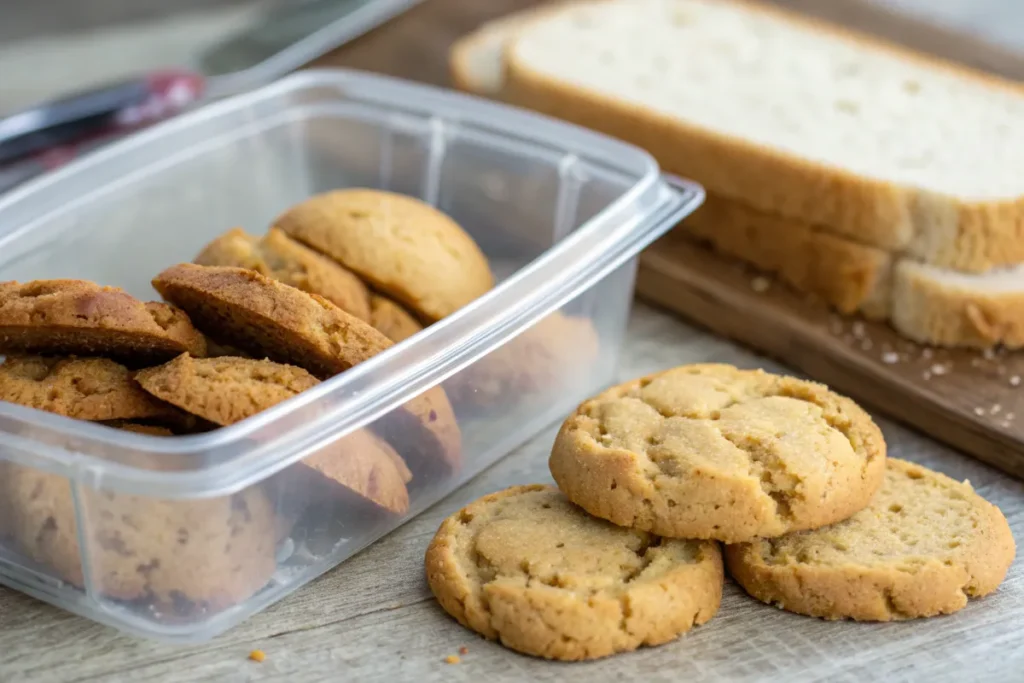
Looking for more cookie recipes? Check out these Vanilla Sandwich Cookies, perfect for soft, chewy cookie lovers!
Using Bread Slices to Keep Cookies Soft
Placing a slice of white bread inside the cookie container can extend chewiness. The cookies absorb moisture from the bread, keeping them softer for longer.
| Storage Trick | Effect on Cookies |
|---|---|
| Adding a Bread Slice | Prevents cookies from becoming stale |
| Using Parchment Paper Between Layers | Stops cookies from sticking together |
Freezing Dough vs. Freezing Baked Cookies
Freezing is a great option for keeping cookies fresh for months.
| Freezing Option | Best For | How to Use |
|---|---|---|
| Freezing Cookie Dough | Freshly baked cookies anytime | Scoop dough, freeze on a tray, then store in a ziplock bag |
| Freezing Baked Cookies | Preserving leftovers | Let cookies cool completely, then freeze in an airtight container |
For quick homemade cookies, freeze pre-portioned dough balls and bake them directly from the freezer.
FAQs About Chewy Cookies
How to Make a Cookie More Chewy?
To enhance chewiness, focus on ingredients and baking techniques:
Use more brown sugar – The molasses content adds moisture.
Melt the butter – Helps create a denser, chewier texture.
Add an extra egg yolk – Increases richness and chewiness.
Use bread flour – Higher protein content results in a chewier bite.
Chill the dough – Allows moisture to distribute evenly.
Underbake slightly – Keeps the center soft and chewy.
What Are Three Factors That Contribute to a Chewy Cookie?
The three main factors that determine cookie chewiness are:
Moisture Content – More moisture leads to a softer, chewier texture.
Sugar Type – Brown sugar and liquid sweeteners (honey, molasses) enhance chewiness.
Baking Time & Temperature – Shorter baking times and slightly underbaking prevent cookies from drying out.
What Makes Cookies Stay Soft and Chewy?
Once your cookies come out chewy and perfect, the next challenge is keeping them that way. Here’s how:
Store in an airtight container – Prevents moisture loss.
Use a slice of bread in the container – Helps maintain moisture.
Avoid refrigerating baked cookies – This can dry them out.
Freeze dough instead of baked cookies – This keeps cookies fresh longer.
Conclusion: Mastering the Art of Chewy Cookies
Achieving the perfect chewy cookie isn’t just about following a recipe—it’s about understanding the science of ingredients, baking techniques, and storage methods. By making simple adjustments, you can control the texture of your cookies and create soft, chewy treats every time.
Key Takeaways for Chewy Cookies:
✔ Use more brown sugar than white sugar to retain moisture.
✔ Melt the butter instead of creaming it for a denser texture.
✔ Add an extra egg yolk for a richer, chewier bite.
✔ Use bread flour instead of all-purpose flour for more chew.
✔ Chill the dough for at least one hour to prevent excessive spreading.
✔ Bake at 350°F and remove cookies when the edges are set but the center is still soft.
✔ Store cookies with a slice of bread to maintain moisture.
By implementing these tricks, you’ll never have to settle for dry or hard cookies again. Whether you love classic chocolate chip cookies, oatmeal cookies, or sugar cookies, these techniques will help you achieve bakery-quality chewiness every time.
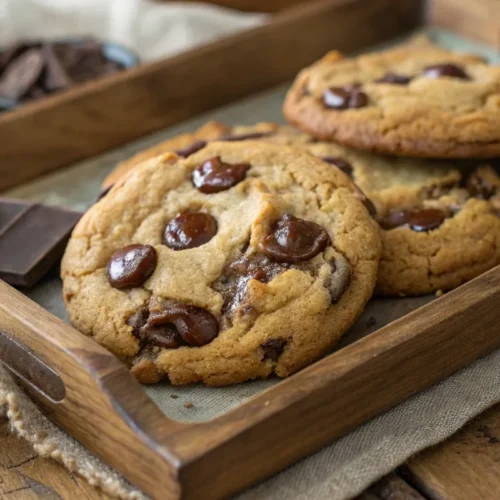
The Ultimate Chewy Chocolate Chip Cookies
Equipment
- Mixing bowls (one large, one medium)
- Whisk
- Spatula or wooden spoon
- Measuring cups and spoons
- Baking sheet
- Parchment paper or silicone baking mat
- Wire cooling rack
- Refrigerator (for chilling dough)
- Oven
Ingredients
- 2 ¼ cups 280g all-purpose flour (or bread flour for extra chewiness)
- 1 teaspoon baking soda
- ½ teaspoon salt
- ¾ cup 170g unsalted butter, melted
- 1 cup 200g brown sugar, packed
- ½ cup 100g granulated sugar
- 1 large egg + 1 egg yolk
- 2 teaspoons vanilla extract
- 1 tablespoon cornstarch for extra softness
- 1 tablespoon milk for moisture retention
- 1 ½ cups 270g chocolate chips
Instructions
- Mix Dry Ingredients: In a medium bowl, whisk together the flour, baking soda, salt, and cornstarch. Set aside.
- Melt Butter & Mix Sugars: In a large bowl, whisk together the melted butter, brown sugar, and granulated sugar until well combined.
- Add Eggs & Vanilla: Mix in the egg, egg yolk, and vanilla extract until smooth.
- Incorporate Dry Ingredients: Gradually add the dry ingredients to the wet ingredients, stirring just until combined. Avoid overmixing.
- Add Milk & Chocolate Chips: Stir in the milk and chocolate chips. The dough will be thick.
- Chill the Dough: Cover the dough and refrigerate for at least 1 hour (or overnight for maximum chewiness).
- Preheat Oven & Prep Baking Sheet: Preheat the oven to 350°F (175°C). Line a baking sheet with parchment paper.
- Scoop & Shape Dough: Roll dough into 2-tablespoon-sized balls and place them 2 inches apart on the prepared baking sheet.
- Bake the Cookies: Bake for 9-11 minutes, or until the edges are set but the centers still look slightly underbaked.
- Cool & Enjoy: Let cookies cool on the baking sheet for 5 minutes before transferring them to a wire rack to cool completely.
Notes
For extra chewiness, substitute ½ cup of the all-purpose flour with bread flour.
Slightly underbaking will keep the centers soft.
Store cookies with a slice of bread in an airtight container to maintain moisture.

